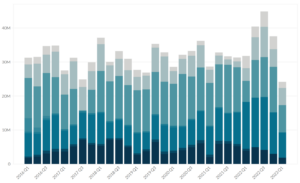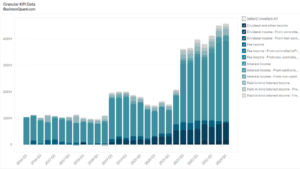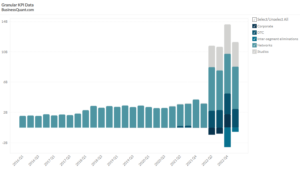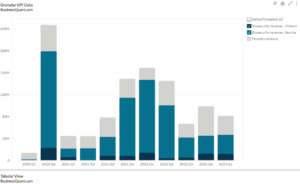
Spirit AeroSystems’ Revenue by Segment (2016-2023)
Exclusive Data
You need the Pro Plan to access KPI data
- Full access to the platform
- KPI data & segment financials on US stocks
- Financial data on thousands of stocks
- Download data in xlsx and csv formats
Pro Plan
$49 per month*
60% discount ends in:
.
About
More information
Subscribe to Pro or Enterprise plans to unlock this feature.
Contact the Analyst
Subscribe to Pro or Enterprise plans to unlock this feature.
Become a smarter investor today.
Access KPIs & Segment Financials on US stocks
This statistic highlights Spirit AeroSystems’ Revenue by Segment, split across Fuselage Systems, Propulsion Systems and Wing Systems segments.
Spirit AeroSystems’ Revenue by Segment
| Revenue by Segment | Q3 2020 | Q2 2021 | Q3 2021 | Contribution in Q3 2021 |
| Fuselage Systems | $421.1 | $492.2 | $481.2 | 49.10% |
| Propulsion Systems | $170.8 | $241.9 | $247.8 | 25.29% |
| Wing Systems | $168.3 | $259.3 | $243 | 24.80% |
| All Other | $46.1 | $8.7 | $8 | 0.82% |
| Total | $806.3 | $1,002.1 | $980 | 100.00% |
(All figures in millions, except percentages)
The Company divides revenue into segments depending whether a performance obligation is met over time or at a specific point in time, the place where products and services are delivered to customers, and main customer segments.
Fuselage Systems, Propulsion Systems, and Wing Systems are the company’s three main segments. The Boeing Company (“Boeing”), Spirit AeroSystems’ largest customer, accounts for a significant share of the company’s revenues across all segments. Furthermore, the Wing Systems segment’s second-largest customer, Airbus Group SE, and its affiliate account for a significant percentage of sales. Clients other than Boeing and Airbus are served by the corporation throughout its three main divisions; however, these customers do not currently account for a major share of revenues and are not projected to do so in the foreseeable future.
The total revenue generated from the segments grew 21.54% on a yearly basis, from $806.3 million in Q3 2020 to $980 million in Q3 2021. However, when compared to Q2 2021, where the revenue generated was $1,002.1 million, the revenue declined by 2.21% on a quarterly basis.
Fuselage Systems
The Fuselage Systems segment is responsible for the development, production, and marketing of the forward section of the aero structure, which houses the flight deck, passenger cabin, and cargo area, the mid and rear fuselage sections, and other fuselage structure components, such as floor beams.
The total revenue generated from this segment grew by 14.27% on a year-on-year basis, from $421.1 million in Q3 2020 to $481.2 million in Q3 2021. However, when compared to Q2 2021, where the revenue generated was $492.2 million, the revenue declined by 2.23% on a quarterly basis.
This segment contributed 49.10% in the latest quarter of 2021. Even though there was a year-on-year increase in revenue generated from the segment, the contribution to revenue fell from 52.23% in Q3 2020 to 49.10% in Q3 2021.
Propulsion Systems
Nacelles (including thrust reversers) which are aerodynamic structures around engines, struts/pylons which are structures connecting the engine to the wing, other structural engine components, and related spares and MRO services are included in the Propulsion Systems division.
The revenue generated from this segment has been increasing over the quarters. When compared to Q3 2020, there was a 45.08% year-on-year increase. The revenue increased 2.44% on a quarterly basis, from $241.9 million in Q2 2021 to $247.8 million in Q3 2021.
The contribution to revenue mix has also been increasing over the quarters, from 21.18% in Q3 2020 to 24.14% in Q2 2021, and further to 25.29% in Q3 2021.
Wing Systems
Horizontal and vertical stabilizers, flaps, and slats which are flight control surfaces, wing structures which is a framework consisting mostly of spars, ribs, fixed leading edge, stringers, trailing edges, and flap track beams which are fully functional and tested wing systems are all part of the Wing Systems segment.
The total revenue generated from this segment grew by 44.39% o a yearly basis, from $168.3 million in Q3 2020 to $243 million in Q3 2021. However, when compared to Q2 2021, where the revenue generated was $259.3 million, the revenue declined by 6.29% quarterly.
All Others
The all other segment consists primarily of miscellaneous sales of miscellaneous services, tooling contracts, and natural gas sales through a tenancy in common with other corporations, with operations in Wichita, Kansas.
The revenue generated from this segment has been on a constant decline. The revenue fell by 82.65% on a yearly basis, from $46.1 million in Q3 2020 to $8 million in Q3 2021. On a quarterly basis, it fell by8.04 % when compared to $8.7 million in Q2 2021. The contribution to revenue mix also fell massively from 5.72% in Q3 2020 to just 0.82% in Q3 2021.
About Spirit AeroSystems
Spirit AeroSystems, which is headquartered in Wichita, Kansas, is one of the world’s leading independent non-OEM commercial aero structures designers and producers. The company designs, engineers, and manufactures structural components for military aircraft and other uses in addition to commercial aircraft structures. The US government has classified a section of its defence business, so it cannot be disclosed in detail. Spirit AeroSystems is a key partner because of the wide range of products it now provides to commercial and defence clients, as well as its superior design and manufacturing capabilities employing both metallic and composite materials.
Did you like Spirit AeroSystems’ Revenue by Segment statistic?
Access more such KPI data points and segment financials on thousands of US stocks, with Business Quant.
You can get started here.
More data on US Stocks

Our Plans
Always know what you’ll pay. No hidden costs or surprises.
- Annual
- Monthly
60% discount till April 30
Pro
For serious investing
-
Company KPI data Access segment financials, non-GAAP metrics and KPI data from presentations and filings. Examples include financials by segment / region / product category, AT&T's broadband subscriber trends, Tesla's deliveries by model and lots more.
-
Stock research tools Features include : stock screener, stock comparison, industry financials, stock warnings, advanced charting tools, timeseries tables, scatter charts, financial statements, stock reports, SEC filings, stock ratings, institutional and insider ownership data. There are 200+ financial items and ratios on thousands of US stocks.
-
Industry data & tools Access premium operating data on 40+ industries. Examples include market share, smartphone shipments by vendor, subscribers by wireless carrier, historical gold production. There are 20,000+ such statistics.
Enterprise
For tailored workflows
-
All of Pro plan Get unfettered access to all our dashboards and dossiers.
-
Custom built features Get tailored dashboards built specially for you , based on your set of requirements, to simplify your research workflow.
-
Admin billing Back-end documentation support and multi-seat licensing.
* Billed annually, local taxes extra.
60% discount on Annual plan
Pro
For serious investing
-
Company KPI data Access segment financials, non-GAAP metrics and KPI data from presentations and filings. Examples include financials by segment / region / product category, AT&T's broadband subscriber trends, Tesla's deliveries by model and lots more.
-
Stock research tools Features include : stock screener, stock comparison, industry financials, stock warnings, advanced charting tools, timeseries tables, scatter charts, financial statements, stock reports, SEC filings, stock ratings, institutional and insider ownership data. There are 200+ financial items and ratios on thousands of US stocks.
-
Industry data & tools Access premium operating data on 40+ industries. Examples include market share, smartphone shipments by vendor, subscribers by wireless carrier, historical gold production. There are 20,000+ such statistics.
Enterprise
For tailored workflows
-
All of Pro plan Get unfettered access to all our features.
-
Custom built features Get tailored dashboards built specially for you , based on your set of requirements, to simplify your research workflow.
-
Admin billing Back-end documentation support and multi-seat licensing.
* Local taxes extra.






